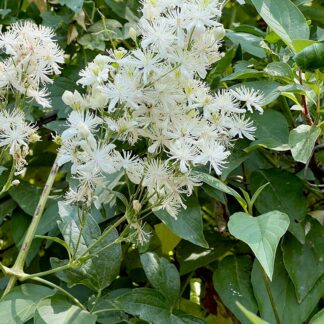riparian
Showing 1–12 of 35 results
-

Acer glabrum / Rocky Mountain maple
- understory shrub, small tree, multiple stems
- opposite leaves; red twigs
- maple-like leaves
- teeny flowers; double-helicopter fruits
-

Angelica arguta / Lyall’s angelica
- white to yellow to pink-ish
- compound umbel with teeny individual flowers
- many-toothed compound leaves with sheath surrounding petiole
- leaflets egg-shaped to narrowly oval
- pungent parsley/celery/anise scent when leaves crushed
-

Anticlea elegans / mountain death camas
- cream to greenish-white flowers; overall hexagonal appearance
- branched flowering stem with multiple flowers not tightly packed
- 6 tepals (petals + sepals), greenish-yellow nectar glands
- grass/lily-like leaves
- blooms in summer (July/August)
-

Artemisia cana / silver sagebrush
- Low perennial, silvery shrub
- Highly aromatic, like sagebrush
- Entire leaves - no lobes
- Nondescript, inconspicuous flowers in small clusters with leaf-like bracts
- Grows in more moist habitat than other Artemisia spp.
-

Cirsium vulgare / bull thistle
- very nasty spines all over, including stems
- purple flower head over pear/egg-shaped narrow, spiny bracts
- fruits are thistle-downy
- disturbed areas, but also forest gaps, stream sides and seeps
-

Clematis ligusticifolia / western white clematis
- climbing vine... makes dense canopy
- in canyons and streamside thickets
- compound leaves with 5-15 leaflets, often widely spaced
- white flowers with 4 "petals", many pistils and stamens — late summer
- fruit is fluffy white cluster in Sept/Oct
-

Cornus sericea / red osier dogwood
- shrub with opposite branching and red bark, brightest in fall/winter
- common along streams especially
- small white flowers, 4 petals, in clusters
- white or blue-ish white berries in fall
- opposite leaves with parallel veins
-

Corydalis aurea / scrambled eggs
- prostrate herb, up to 15" tall
- moist but well-drained soils, including on roadsides
- yellow tubular flowers, with spurs
- highly dissected leaves, blue-grey except when young
- fruits are pod-like, resembling peas or beans
-

Crataegus douglasii / black hawthorn
- slightly thorny shrub or small tree, to 30 feet
- often forms thickets
- broad leaves with toothed edges, clumped at ends of branches
- clumps of white, globe-shaped flowers in spring; prominent black anthers
- clumps of black "berries" in autumn
-

Cynoglossum officinale / houndstongue
- reddish-purple flowers in upper leaf axils
- forms basal rosette with hairy leaves in first year
- stem leaves lance shaped, hairy, rough
- fruit - small nutlets with barbs or hooks
-

Equisetum arvense / field horsetail
- segmented brown stems with spore-bearing "cone" at the tip
- or - segmented green stem with thin green branches radiating from nodes
- distinctly visible nodes along the stems
- no leaves or flowers
- found in many different habitats
-

Equisetum hyemale / rough horsetail
- thin green stems with black bands; no branches
- possible cone-like structure at the apex
- usually in large colonies
- prefers continuously moist soils
Showing 1–12 of 35 results